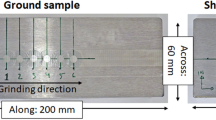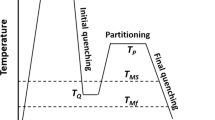Abstract
Continuous cooling transformation diagrams were obtained for a simulated coarse-grain heat-affected zone of API X-80 and X-65 steels using Gleeble-3800 thermo-mechanical simulator. Dilatometry results showed that variable cooling rates have significant effect on phase transformation behaviour and microstructure of the steels. For X-80 steel, a mixture of bainite/martensite at fast and medium cooling rates and ferrite/pearlite at slow cooling rates was obtained and confirmed by microhardness measurements between 340 and 240 HV, whereas, for X-65 steel soft phase such as ferrite was nucleated along with bainite at moderate (15–100 °C s−1) and pearlite at slow cooling rates (3–10 °C s−1). Dilatometry curve comprises inherent noise, and Loess computational filter was used to filter background noise in the curves. Martensite/bainite and ferrite/pearlite coexisted for most cooling rates, which made it difficult to distinguish transformation kinetics of individual phases. In the first derivative analysis d/dT {(ΔL/Lo)} of dilatometry curves, peaks of individual phases were clearly observed. Peaks of individual phase were separated according to their transformation temperature range, and peak rate temperatures were determined. It was confirmed that the first derivative d/dT {(ΔL/Lo)} analysis described phase transformation behaviour precisely and aided in identification of the transformed phases.











Similar content being viewed by others
References
Goodall GR. Welding high strength modern line pipe steel. Ph.D. thesis. 2011. http://digitool.library.mcgill.ca/R/?func=dbin-jump-full&object_id=96662&local_base=GEN01-MCG02.
Shome M, Mohanty ON. Continuous cooling transformation diagrams applicable to the heat-affected zone of HSLA-80 and HSLA-100 steels. Metall Mater Trans A. 2006;37(7):2159–69.
Chen XW, Qiao GY, Han XL, Wang X, Xiao FR, Liao B. Effects of Mo, Cr and Nb on microstructure and mechanical properties of heat affected zone for Nb-bearing X80 pipeline steels. Mater Des. 2014;53:888–901.
Harrison PL, Farrar RA. Application of continuous cooling transformation diagrams for welding of steels. Int Mater Rev. 1989;34(1):35–51.
Easterling K. Introduction to the physical metallurgy of welding. Amsterdam: Elsevier; 2013.
Shome M, Gupta OP, Mohanty ON. Effect of simulated thermal cycles on the microstructure of the heat-affected zone in HSLA-80 and HSLA-100 steel plates. Metall Mater Trans A. 2004;35(3):985–96.
Yue X, Lippold JC, Alexandrov BT, Babu SS. Continuous cooling transformation behaviour in the CGHAZ of naval steels. Weld J. 2012;91(3):67s–75s.
Zhang YQ, Zhang HQ, Liu WM, Hou H. Effects of Nb on microstructure and continuous cooling transformation of coarse grain heat-affected zone in 610 MPa class high-strength low-alloy structural steels. Mater Sci Eng A. 2009;499(1):182–6.
Thompson SW, Colvin DJ, Krauss G. Austenite decomposition during continuous cooling of HSLA-80 plate steel. Metall Mater Trans A. 1996;27(6):1557–71.
Rivolta B, Gerosa R, Tavasci F. The dilatometric technique for studying sigma phase precipitation kinetics in F55 steel grade. J Therm Anal Calorim. 2018;132(2):869–77.
Hebda M, Dębecka H, Kazior J. Dilatometric study of low-alloy steels with silicon carbide addition. J Therm Anal Calorim. 2016;125(3):1319–26.
Tripathy H, Rai AK, Hajra RN, Shanthi NV, Subramanian R, Saibaba S. High-temperature thermo physical properties of 18Cr–9Ni–2.95 Cu–0.58 Nb–0.1 C (mass%) austenitic stainless steel. J Therm Anal Calorim. 2018;131(3):2749–61.
Spanos G, Fonda RW, Vandermeer RA, Matuszeski A. Microstructural changes in HSLA-100 steel thermally cycled to simulate the heat-affected zone during welding. Metall Mater Trans A. 1995;26(12):3277–93.
Bandyopadhyay PS, Kundu S, Ghosh SK, Chatterjee S. Structure and properties of a low-carbon, microalloyed, ultra-high-strength steel. Metall Mater Trans A. 2011;42(4):1051–61.
Herrejón-Escutia M, Solorio-Díaz H, Javier Vergara-Hernández H, López-Martínez E, Vázquez-Gómez O. Dilatometric model for determining the formation of austenite during continuous heating in medium carbon steel. J Therm Anal Calorim. 2018. https://doi.org/10.1007/s10973-018-7449-7.
Kawuloková M, Smetana B, Zlá S, Kalup A, Mazancová E, Váňová P, Kawulok P, Dobrovská J, Rosypalová S. Study of equilibrium and non-equilibrium phase transformations temperatures of steel by thermal analysis methods. J Therm Anal Calorim. 2017;127(1):423–9.
Grajcar A, Zalecki W, Skrzypczyk P, Kilarski A, Kowalski A, Kołodziej S. Dilatometric study of phase transformations in advanced high-strength bainitic steel. J Therm Anal Calorim. 2014;118(2):739–48.
Park BJ, Choi JM, Lee KJ. Analysis of phase transformations during continuous cooling by the first derivative of dilatation in low carbon steels. Mater Charact. 2012;64:8–14.
Wang J, Vander Wolk PJ, Vander Zwaag S. On the influence of alloying elements on the bainite reaction in low alloy steels during continuous cooling. J Mater Sci. 2000;35:4393–404. https://doi.org/10.1023/A:1004865209116.
Thewlis G. Classification and quantification of microstructures in steels. Mater Sci Technol. 2004;20(2):143–60.
Bhadesia H, Honeycombe R. Steel: microstructures and properties metallurgy and materials science. Butterworth-Heinemann; 2017.
Chen XW, Qiao GY, Wang X, Xiao FR, Liao B. Study on microstructure and mechanical properties of welding coarse grain heat-affected zone of high-Nb X80 steels. Adv Sci Lett. 2012;13(1):780–3.
Mohseni P, Solberg JK, Karlsen M, Akselsen OM, Østby E. Cleavage fracture initiation at M–A constituents in intercritically coarse-grained heat-affected zone of a HSLA steel. Metall Mater Trans A. 2014;45(1):384–94.
Gianetto JA, Fazeli F, Chen Y, Shalchi-Amirkhiz B, Smith T. Microstructure and toughness of simulated grain coarsened heat affected zones in X80 pipe steels. In: 2014 10th international pipeline conference. American Society of Mechanical Engineers; 2014.
Acknowledgements
The authors are grateful to the NIT Jalandhar, Tata Steel Limited, Jamshedpur, and CSIR-NML Jamshedpur for providing facilities and support to carry out this work.
Author information
Authors and Affiliations
Corresponding author
Additional information
Publisher's Note
Springer Nature remains neutral with regard to jurisdictional claims in published maps and institutional affiliations.
Rights and permissions
About this article
Cite this article
Singh, M.P., Arora, K.S., Shajan, N. et al. Comparative analysis of continuous cooling transformation behaviour in CGHAZ of API X-80 and X-65 line pipe steels. J Therm Anal Calorim 137, 1155–1167 (2019). https://doi.org/10.1007/s10973-019-08023-z
Received:
Accepted:
Published:
Issue Date:
DOI: https://doi.org/10.1007/s10973-019-08023-z




